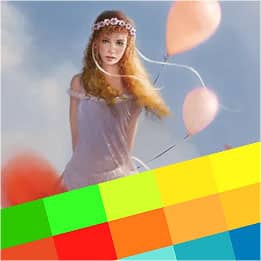Henning’s 101: Seasons
Let’s go for a walk through all of the four seasons of the year and study their unique characteristics.
You can add a lot more depth and life to your paintings if you also consider the environment your subjects are placed in. By adding a hint of specific seasons, or simply some sort of influence by weather conditions you’re suddenly adding a whole another dimension to your art. Let’s go for a walk through all the four seasons of the year and try to break down and understand a little more about the most characteristic elements from each of them. It’s all about getting into the mindset of including these elements in your paintings.
Spring
Spring is all about rebirth; the start of something new and fresh. Using greens with a leaning towards cold blue values will make your foliage and grass appear different than warmer greens which should be used for mid summer. Blossoming trees are probably the most recognizable visual element for spring, and it’s a safe bet when wanting to achieve the right feel for this season. Also keeping the sunlight slightly colder than usual might add to this impression as well.
Painting Chinese gardens with beautiful and colourful blossoming trees and falling petals trigger instant associations to spring. This painting done by Dan Horward (guest art for Anima RPG) is showing these elements efficiently. Here you see the clear air, the blossoming trees with white and pink flowers. By painting falling petals you achieve this very special and almost eerie mood that are to be found in these types of paintings.
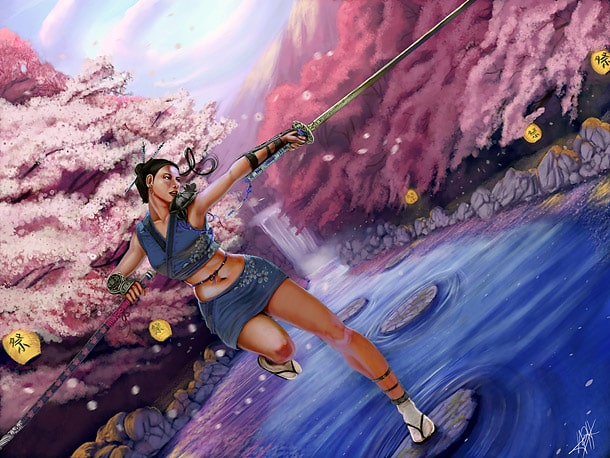
(C) Dan Howard
Phoenix Feng is taking advantage of the more traditional elements and symbols of spring in this beautiful spring-painting. Here we see the clear air, and that almost cold green colour scheme that makes it all seem fresh and sparkly new. By painting a wide variety of flowers, both in shapes and colours, he symbolizes all sorts of life springing to life.
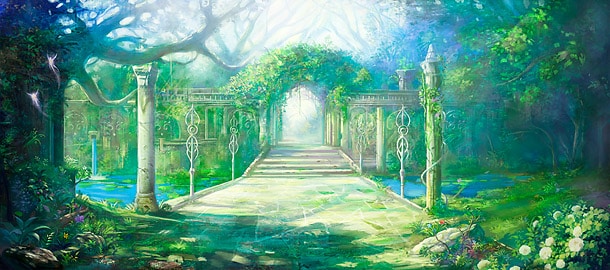
(C)Phoenix Feng
Check-list for spring:
- Trees with new sprung leaves.
- Blossoming trees.
- Petals from fruit trees.
- New sprung flowers of all shapes and colours.
- Sharp, almost cold light.
- Fresh grass and foliage, cold green in colour.
Colour palette suggestion for spring contains cold colours, often bright with a fair amount of white and blue added to the mix.

Summer
Summer should signify life. Use warm colours for the sunlight, and keep the grass and foliage lush with warm green values. Mixing in varieties of flowers, and painting in some nice and puffy clouds will add to the summery feeling.
Make sure to include elements of life; varying from lush trees and colourful vegetation to flying birds, butterflies and clear skies behind puffy clouds, as shown here by Phoenix Feng. Focusing on a wide variation of flowers and grass in the foreground makes us conceive it as if the entire meadow is filled with the same variety, even though it have been nicely simplified.
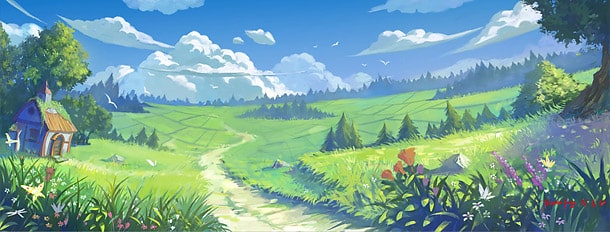
(C)Phoenix Feng
Focusing more on light and fresh summery wind, as done here by Natascha Roeoesli makes for a slightly different approach, but still with a similar feeling as a result. The transparent summer dress and balloons caught both by the summer sun and the wind leaves no doubt for which season we’re looking at. The wreath of flowers around the girls head is a nice way in implementing seasonal elements into a painting.
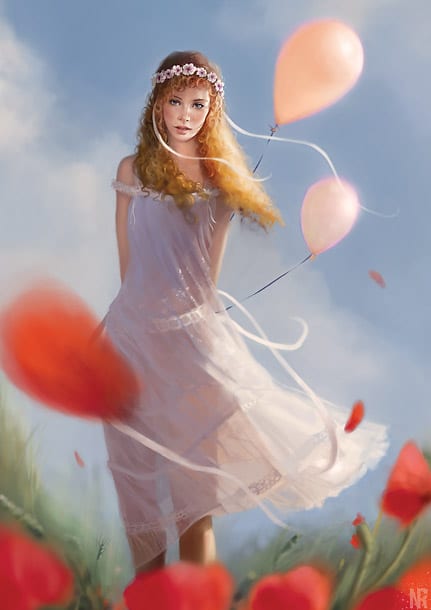
(C) Natascha Roeoesli
Check-list for summer:
- Green leaves and foliage, warmer green tones.
- Flowers of all shapes and variations, fully sprung.
- Thick and lush grass.
- Blue skies behind white, puffy clouds.
- Summery wind.
- Flying birds, butterflies, and other insects.
Colour palette suggestion for summer contains warm, sunny colours. Greens should have warm influences, and the colours can have strong saturation.

Autumn
Autumn should show decay, but in a beautiful way. Using strong yellows and reds for foliage and grass is obvious, and warm colours for the sunlight as well. This season is also great for painting stormy weather with dark, threatening clouds, rain, and puddles on the ground.
According to many artists; autumn makes for one of the most interesting seasons to paint. This because of the amazing variety of warm colours and shifting weather conditions, opening for some very dramatic artistic opportunities.
In this example by Phoenix Feng, he is taking excellent advantage of the autumn colour scheme of yellows, reds and dark greens for the decaying grass and foliage. The naked trees looks great combined with the rocks and the warm colours of the surrounding vegetation.
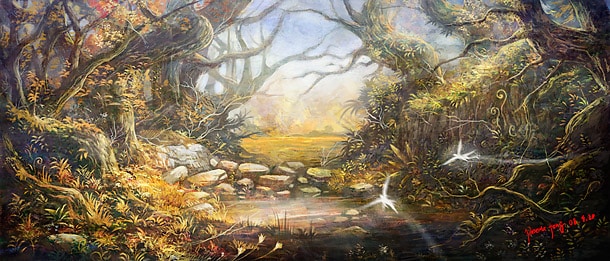
(C)Phoenix Feng
Marek Okon illustrates how to achieve the effect of falling rain in this excellent piece of his. It’s hard to paint falling rain convincingly; and it takes a few tries and failures before you understand how the receipt works. As seen in this example; the direction of all the falling raindrops are not completely parallel, which adds adds to the effect of realism and hinting that there’s wind influencing the rain. Also, making sure not to keep the rain too sharp, or neither too blurry is a balance that has to be adjusted to every single situation in your paintings. Splashes upon impact and drops of water running down the character in this piece really puts her IN the rain and adds that interaction needed for a painting to succeed as well as this one clearly does.
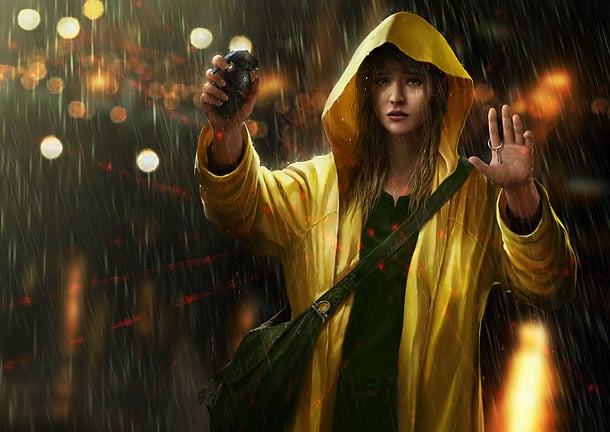
(C) Marek Okon
Puddles of water and water splashes is another effect to consider using for creating that characteristic autumn feeling. Don’t copy and flip the scenery vertically to create reflections, that ONLY works when the point of view is exactly on the same level as the reflective surface. Do like Andreas Rocha in this example; by merely hinting the most visible elements in the reflection, and adding surface to the puddles either by painting horizontal lines or add some minor horizontal smudges, which will function as ripples, to break up the reflective surface a bit.
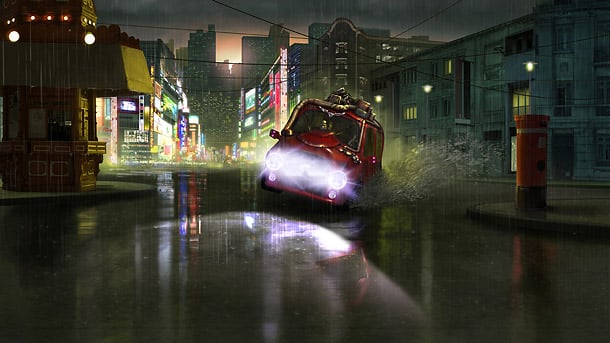
(C) B-Reel SciFi Channel / Andreas Rocha
Check-list for autumn:
- Yellow, red and dark green leaves.
- Falling rain.
- Water splashes to make elements or characters interact with the falling rain.
- Water puddles with hinted reflection and ripples.
- Stormy clouds.
- Windy trees.
- Mushrooms.
- Wet grass, yellow, red and dark green colours.
Colour palette suggestion for autumn should contain warm and dirty earth colours, varying from less to strong saturation.
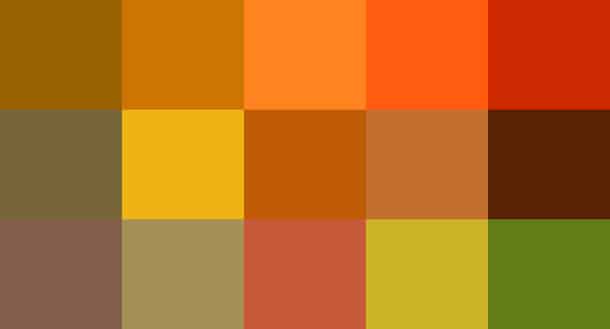
Winter
Winter can be related to death, but in a slightly different meaning of the word. Nature stands still, trees are bare and leafless and often with branches frozen to the core. The interesting thing with winter is the contrast between white and the earthly colours, and that using both clear sunny winter days and agressive snowstorms will still illustrate this season.
In this example by Daniela Uhlig, she has managed to capture a moment of calmness, with the puffy, falling snowflakes painted in such a way that you know they are falling slowly and doesn’t get much influence by wind. Be careful not to paint falling show to sharp as they will work as attention seekers, making the painting confusing and hard to read. Daniela also painted in some flow flakes getting caught by the fur trimming of the girls hood, which does the same purpose as water splashes in rainy weather; it interacts the characters with the weather.
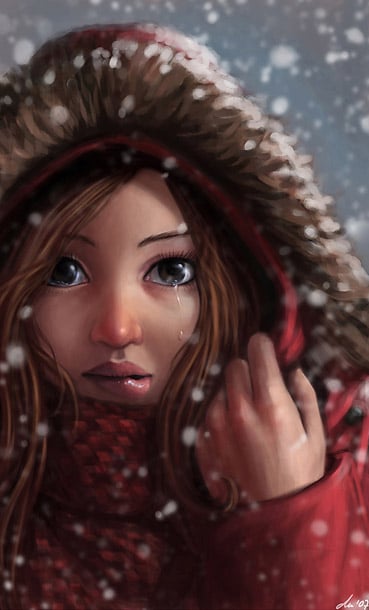
(C) Daniela Uhlig
Michal Ivan went for a more stormy and aggressive expression when painting this piece. The dark clouds, the clothes getting caught in the cold winter wind and the falling snow seemingly coming from all directions makes up for a nice and stormy composition.
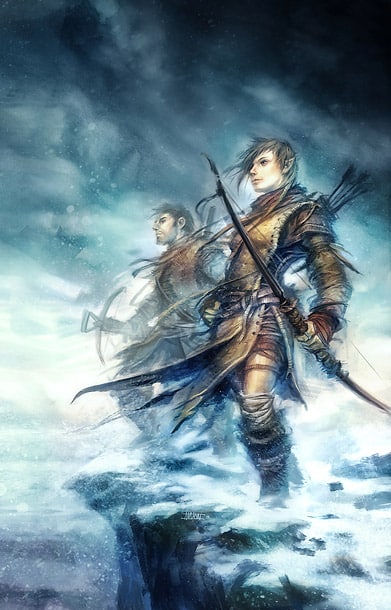
(C) Michael Ivan
Try something different; you don’t have to use blue palettes exclusively to paint an arctic or snow-clad landscape; what happens when the sun is low, bathing the environment in warm red light? Snow and ice can clearly consist of warm colours as well, as proven here by Daniel Kvasznicza.
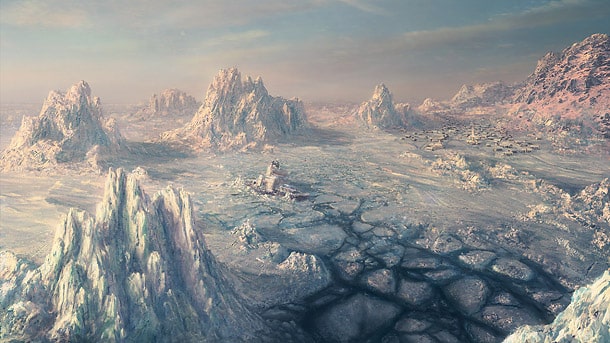
(C) Daniel Kvasznicza
Check-list for winter:
- Naked branches, often covered in show or frozen.
- Snow on ground.
- Falling snow, not too attention seeking.
- Ice.
- Both clear days and snowstorms.
- Blue colours influencing shadows and environments.
Colour palette suggestion for winter should naturally contain cold colours, from bright grey, to blue tones and also with influences with greens when painting ice. Still, remember that snow doesn’t have to appear white or blue, playing around with the colour of the light can open for many interesting and dramatic scenarios in your art.


